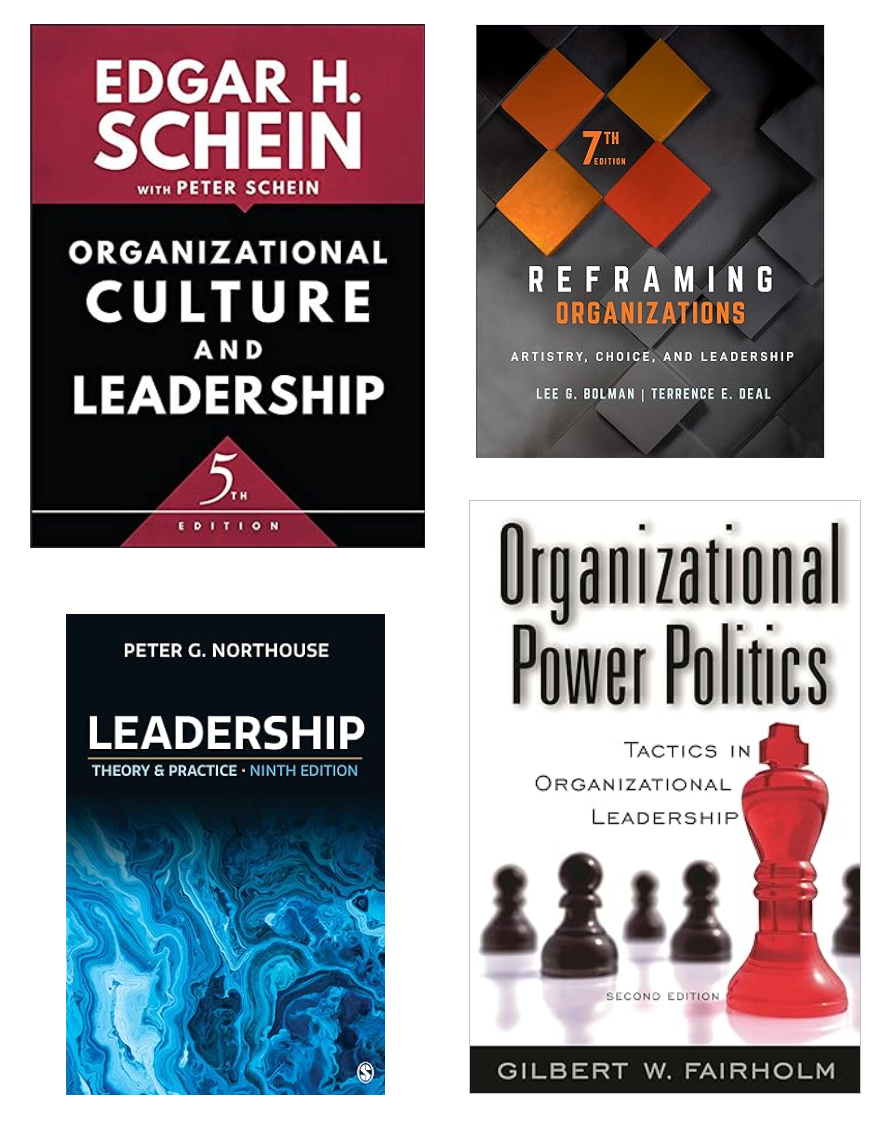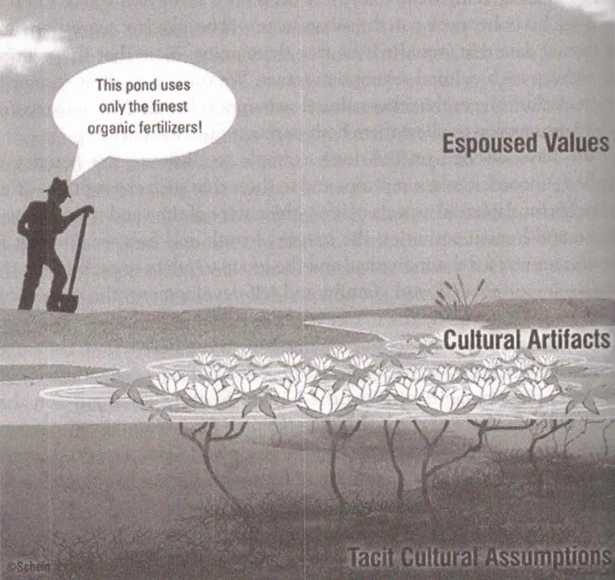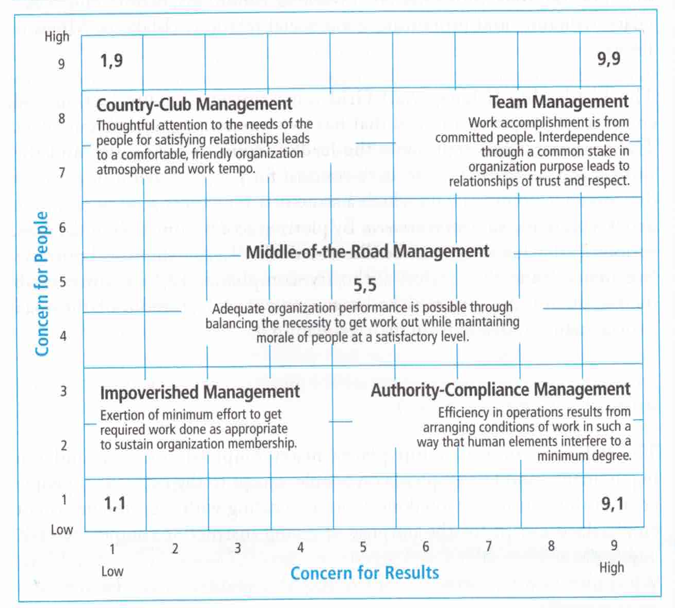
Reading List: Organizational Leadership
Author: Johannes Traa
January 2, 2024
Summary
This is a summary of four of my favorite books on leadership in an organizational setting. They provide frameworks to help us make sense of what we see and shape our strategies around decision-making and communication. The authors vary in their focus from group culture to power and politics. Enjoy!
Book list
Organizational Culture and Leadership (Edgar Schein)
Edgar Schein has a knack for taking something as complicated as organizational culture and distilling it into simple, actionable ideas. You know a book is packed with useful perspectives when you read it the first time, find it insightful, and then read it again six months later only to realize how little you picked up on the first time. And then, to your surprise, the same thing happens a third time. Good grief.
The core idea of the book (Schein, 2017) is the lily pond metaphor. It describes organizational culture as consisting of three distinct levels. Above the surface we find espoused beliefs: ideals, goals, aspirations, ideologies, rationalizations. This is what you get when you ask a group to describe itself. What you get is outward-facing narratives that have evolved to benefit the group.

The lily pond metaphor.
Source: Schein (2017, p. 26).
If you observe the group, you will see what's on the surface of the pond: cultural artifacts that serve as the "visible and feelable structures and processes". These can be hard to decipher at first glance because they might not seem to align with the group's espoused beliefs. People say one thing but then do another. Huh.
Only when your stay is extended do you gain a deeper understanding of what's beneath the surface of the lily pond: the "unconcious, taken-for-granted beliefs and values" that drive behavior. These may or may not have anything to do with the group's espoused beliefs and observable artifacts. They constitute a set of strategies that the group has accepted over time as "good" and that have faded out of awareness. Many group members are unaware of this underbelly.
A nice example is unlimited PTO. Company representatives say that "everyone is free to take as much time off as they like". In reality, the ensuing workplace dynamics are such that employees often take less time off on average as compared to a fixed-time-off plan (Sammer, 2020).
In the book, Schein examines in great depth how this model applies to several companies that he consulted for over the years. You see how to apply the model and appreciate how much time and care it can take to do so accurately.
The lily pond metaphor is powerful because it allows you to understand group members' decision-making in a holistic way. Someone may confidently tell you something that you know is certainly untrue. In light of the lily pond metaphor, you can reframe such seeming misdirections as espoused beliefs that hold clues about underlying assumptions driving the group's thinking. Organizational learning (Argyris & Schon, 1978) depends heavily on leaders taking on the responsibility of precisely this kind of introspection.
Reframing Organizations (Lee Bolman, Terrence Deal)
This book describes Bolman and Deal's four-frame model of organizations (Bolman & Deal, 2022). I was so smitten with the framework that I devoted a whole blog article to it.
The idea is that you can view organizations through four lenses: structural, human resource, political, and symbolic. One of its most helpful aspects is that it give you options. Some situations lend themselves to a structural interpretation while others scream political frame. The symbolic frame is especially fun because it depicts a workplace as essentially a theatrical production with actors playing out roles and professing rousing narratives. It really does explain a lot.
Leadership (Peter Northouse)
Researchers have been trying to understand leadership for a while now. They've figured out a lot but have yet to come up with a single formula describing what makes for an effective leader. Turns out it's complicated, surprise surprise.
The effort was initially to understand what makes leaders distinct from non-leaders, with the thinking being that they were just born different. With time, researchers have evolved the concept towards being a more dynamic interplay between leaders and followers in which the two influence each other in a kind of symbiotic dance.
How do we make sense of all the theories? That's where Northouse's book (Northouse, 2016) comes in. It covers the last 100+ years of thinking on the subject. Going down the list, we have models based on traits, skills, and behaviors from the first half of the 20th century. Then there's situational leadership, also known as the SL2 model (Blanchard, 1985). That one opened people's eyes to the idea that effective leadership doesn't exist in a vaccuum. Instead, it depends heavily on followers' readiness. It's also the first truly prescriptive model, meaning that it tells you how to behave in different situations. So that's convenient.
Next is path-goal theory and leader-member exchange (LMX), both of which focus more on the interplay between leader and follower. Tons of industrial-organizational psychology research is underway these days applying LMX to the workplace.
There are also several theories that look much deeper into the leader's motivations, purpose, symbolic meaning in the eyes of followers, etc. This set of theories includes transformational, authentic, and servant leadership. A friend of mine pointed out that a lot of the most famous authentic leaders (e.g. MLK, Mandela, Lincoln) were assassinated or thrown in jail. So they're inspiring and leave a legacy behind, but aren't always very good at surviving society's reaction to their ideas. No one said leadership would be easy.

The leadership grid.
Source: Northouse (2016, p. 76).
The theories are no doubt thought-provoking, but one of the handiest tools is the figures summarizing each one. Many leadership models are depicted as a flow chart emphasizing the process nature of it all. Others fit on a 2D graph called the "leadership grid" (Blake & McCanse, 1991) with "concern for people" on the vertical axis and "concern for production" on the horizontal axis. SL2, the behavioral model, even Daniel Goleman's leadership styles (Goleman, 2019) can be mapped to this chart.
The book also addresses adaptive leadership, psychodynamic theories, ethics, and gender. It's a nice in-depth coverage of the field.
Organizational Power Politics (Gilbert Fairholm)
Something that comes up again and again in the study of leadership is the importance of political skills. Leadership is a process of influencing others to move in a particular direction and the language of influence is politics. Given how quickly organizations have to adapt these days, a political skillset is more important than ever.
Fairholm's book (Fairholm, 2009) on the subject lays out the results of a multi-industry study of all the ways people attempt to influence each other. One thing they found is that the tactics are target-dependent. The way you influence superiors is markedly different from how you influence peers and likewise with subordinates.
There are so many take-aways from this book that it's hard to know where to start. The discussion of how power flows through an organization is very insightful, especially if you've never encountered the literature on bases of power before. Another insight is the flavor of power tactics used with different groups.
Subordinates typically influence their superiors through a blend of initiative and ingratiation. The idea is to make yourself appear useful to them while boosting their ego. At the same time, a clever tactic used with superiors is "ambiguity", which boils down to saying that you don't have all the information yet and we have to wait and see. Your boss can't tell you what to do as easily if you don't tell them what's going on. So keeping your manager in suspense is absolutely a valid tactic, just not a first resort.
Peers influence each other mostly through quid pro quos and coalition-building gestures. They have relatively equal power and so end up influencing each other through what amounts to social obligation. "I did this for you, can you do that for me?" Exchanges involving access to resources (including information) are especially prominent.
Finally, superiors generally influence their subordinates through management and rewards. You direct your subordinates on how to do their jobs, develop them, and reward them when they do things "right".
There's a lot of discussion in the book about how often each tactic is used, how ethically they are perceived as being, and how to counter resistance to their use. There's literally a chapter entitled "How inner leaders get willing compliance". Excellent read.
References
Argyris, C. & Schon, D. A. (1978). Organizational Learning: A Theory of Action Perspective. Addison-Wesley.
Blake, R. R. & McCanse, A. A. (1981). Leadership Dilemmas: Grid Solutions. Gulf Publishing Company.
Blanchard, K. H. (1985). SLII: A Situational Approach to Managing People. Blanchard Training and Development.
Bolman, L. G. & Deal, T. E. (2022). Reframing Organizations: Artistry, Choice, and Leadership (7th ed.). Jossey-Bass.
Fairholm, G. W. (2009). Organizational Power Politics: Tactics in Organizational Leadership (2nd ed.). Praeger.
Goleman, D. (2019). The Emotionally Intelligent Leader. Harvard Business Review Press.
Northouse, P. G. (2016). Leadership: Theory and Practice (7th ed.). Sage.
Sammer, J. (2020). 4 Lessons About Unlimited Vacation. https://www.shrm.org/topics-tools/news/benefits-compensation/4-lessons-unlimited-vacation
Schein, E. H. (2017). Organizational Culture and Leadership (5th ed.). Wiley.